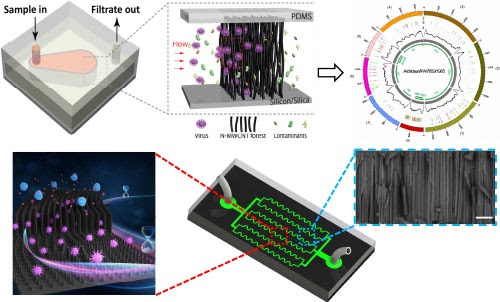Nanomaterial-integrated microdevice for size-based virus capture
Most of the discovered human viral pathogens have sizes ranging from 20 nm to 300 nm. This is a unique size range that between micrometer-sized bacteria and mammalian cells, and biological small molecules and macromolecules (e.g. proteins, nucleic acids). Recently we invented nanomaterial-integrated microdevice technologies that enriches virus particles unbiasly from field and clinical samples.
In one case (top), we integrated vertically aligned carbon nanotube (VACNT) nanostructures silicon substrate to achieve label-free virus capture. We can control the inter-tubular distance between CNTs in the range between 25 nm to over 300 nm, perfectly matching the size range of viruses. The unique structure of the VACNT forest presents high porosity of over 90%, which minimizes flow resistance, increases sample capacity, and minimizes device clogging. The technology can prepare field and clinical samples for virus discovery. Using the microdevice, we successfully identified an emerging avian influenza virus (AIV) from swab samples and a new strain of infectious bursal disease virus (IBDV) from a small piece of turkey tissue.
In another example (bottom), we developed a microfluidic device integrated with biodegradable silicon nanowires for virus capture and analysis. The device enables operation in continuous flow mode and virtually eliminates channel clogging. In addition, viruses can be released later and collected at the outlet by degrading the porous silicon nanowires in phosphate buffered saline for 24 hours. With this system, we demonstrated label-free AIV capture and release.

References:
-
Tunable and label-free virus enrichment for ultrasensitive virus detection using carbon nanotube arrays, Y.-T. Yeh, Y. Tang, A. Sebastian, A. Dasgupta, N. Perea-Lopez, I. Albert, H. Lu, M. Terrones, and S.-Y. Zheng, Science Advances, 2, e1601026, 2016. [Link] [pdf] [video] [PSU News Release] [NIH Director's blog]
-
Label-free virus capture and release by a microfluidic device integrated with porous silicon nanowire forest, Y. Xia, Y. Tang, X. Yu, Y. Wan, Y. Chen, H. Lu, S.-Y. Zheng, Small, 13 (6), 1603135, 2017. (Feature as inside front cover story) [Link]
Nanomaterial-integrated microdevice for virus detection
For targeted virus diagnosis, nanomaterial-integrated microdevice can boost detection sensitivity and selectivity. We developed a nanomaterial-integrated microdevice with surface conjugated antibodies to capture specific viruses and detect them by on-chip ELISA assay. 3D randomly oriented zinc oxide (ZnO) nanorods were fabricaed into several branched microchannels on glass surface for multiplex virus detection. The 3D nanostructure not only provides more binding sites for the virus capture, but also enhances fluorescence detection. The captured viruses can be released by simply dissolving the ZnO nanorods at slightly acidic environment.

References:
-
A Nanostructured Microfluidic Immunoassay Platform for Highly Sensitive Infectious Pathogen Detection, X. Yu, Y. Xia, Y. Tang, W.-L. Zhang, Y.-T. Yeh, H. Lu & S.-Y. Zheng, Small, 13, 1700425, 2017. (Feature as inside front cover story) [Link] [Nanowerk]
-
Highly sensitive DNA detection using cascade amplification strategy based on hybridization chain reaction and enzyme-induced metallization, X. Yu, Z.-L. Zhang and S.-Y. Zheng, Biosens. Bioelectron., 66, 520-526, 2015. [Link]